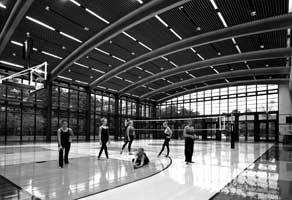| 
The
Ross School: Rich in Ideas
by
Joan Baum, Ph.D.
Despite
facts to the contrary and numerous interviews with the press,
the 13-year old independent, co-educational Ross School still
seems to be correcting the impression of being a New Age, artsy
prep school for gifted rich kids. Talk to students, parents,
and teachers, however—even more to outside educators from around
the country and abroad who visit and evaluate the school’s
imaginative program, with its Integrated Curriculum centered
on an interdisciplinary Spiral of Cultural History (studying
periods through history, the arts, science, literature, modern
and classical language, music, theatre, mathematics, media
studies)—and a much different impression emerges. In the words
of one parent, a retired professor of English and Comparative
Literature with a reputation for skepticism, Ross gave his
daughter, a freshman now at Barnard, “a first-rate education.” Besides,
as Director of Admissions and Community Affairs Stephanie Flagg
notes, Ross is a “lab school,” a work in progress, constantly
being refined.
The
school sits on 140 wooded acres in East Hampton founded by
Courtney Ross Holst, whose first husband, Steve Ross, was head
of Time Warner. Seeing Ross is to appreciate the truth of the
cliché about the best that money can buy. The school is stunningly
handsome, a new and renovated architectural wonder with interiors
likely to stagger even a designer’s imagination. It also boasts—justifiably—superb
high-end technology, including sophisticated projection systems,
state-of-the-art pavilions, seminar rooms, smart boards, laptops
for all, and knockout multimedia enhancements everywhere. Libraries
abound, nothing is single or merely decorative. Classrooms
recreate environments under study—the art and artifacts of
a period, its textures, colors, materials, though the pervasive
influence, warm and subtle earth tones, is Swedish and Asian.
And would you believe a hall showing the history of art by
way of vinyl reproductions done to scale?
The
educational philosophy that infuses the curricula comes from
Harvard professor Howard Gardner, who promotes the idea of “multiple
intelligences”—visual/spatial, musical, verbal, logical/mathematical,
interpersonal, and bodily/kinesthetic. Ross students pursue
interests that engage their innate intelligence and skills,
but all students must take a core of classes throughout their
middle and high school years to expose them to the broad “evolution
of consciousness” that marks cultural history. Thus, a diversity
of ways of learning is complemented by a commonality of information
and knowledge. Jenn Cross, an artist, and dean of the Visual
Arts program proudly displays senior project notebooks on the
theme of “movement” in the Renaissance—everyone drew, did mathematical
calculations, analyzed art, literature and science.
Under
the concept of multiple intelligences, no one fails (though
not all who apply to Ross are admitted). Students are graded
satisfactory, proficient, or distinguished (20 percent of this
June’s graduating class). And life after Ross?—Though 43 percent
are the first in their families to go on to college, graduates
go on to the ivies, prestigious state schools, professional
institutes. Kelly Dennis, a Native American, has just started
at Middlebury College on full scholarship and will be studying
political science and Japanese. Another noted graduate, Nicole
Ross, has just entered her junior year at Barnard.
Prominent
in the Ross integrative model is wellness, a program of sports,
nutrition, health education. The multipurpose Gym/Theatre faces
west, to get the warming light, and under the enlightened and
expert direction of Ross School Executive Chef and director
of Wellness and Nutrition, Ann Cooper, regional, organic and
sustainable foods for both breakfast and lunch have replaced
junk food, just as sitting down at a table, after checking
one’s shoes, supplants eating on the run. As for that myth
about privileged only—Ross food is served at the Bridgehampton
school, and a Kellogg grant has made it possible for Cooper
to extend the program to New York City public schools.
Although
tuition is in the private-school range ($16,000 for the Middle
School and $17,875 in 2002-3) with a 25 percent increase this
year, approximately 45 percent of the school’s 284 students
last year received financial aid. The cynical European professor
comments that a friend of his daughter paid “only ten percent
of all costs, including the trips to Europe, and a fair proportion
of the students come from the Shinnecock reservation.” He also
notes approvingly the school’s focused and sympathetic inýividual
attention and support services. Classes are small—four groups
of 16 each—attrition is low, between 36 percent, and collaborations,
such as with East Hampton Day Care and East Hampton High School
are always under consideration, says Jenn Chidsey, Director
of Curriculum & Assessment.
The
enthusiasm, camaraderie, dedication seem genuine—it’s August
and the teachers are on a one-month retreat at the school.
They’re relaxed and smiling. It can’t all be due to Ann Cooper’s
delicious chocolate cookies.#

Education
Update, Inc., P.O. Box 1588, New York, NY 10159.
Tel: (212) 477-5600. Fax: (212) 477-5893. Email: ednews1@aol.com.
All material is copyrighted and may not be printed without express consent of
the publisher. © 2003.
|
